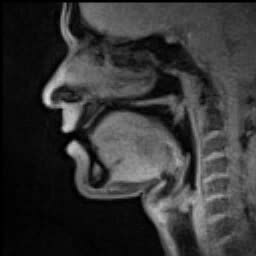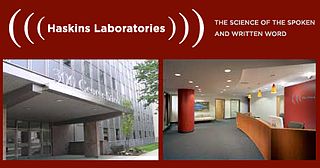Phonetics is a branch of linguistics that studies how humans produce and perceive sounds, or in the case of sign languages, the equivalent aspects of sign. Linguists who specialize in studying the physical properties of speech are phoneticians. The field of phonetics is traditionally divided into three sub-disciplines based on the research questions involved such as how humans plan and execute movements to produce speech, how various movements affect the properties of the resulting sound, or how humans convert sound waves to linguistic information. Traditionally, the minimal linguistic unit of phonetics is the phone—a speech sound in a language which differs from the phonological unit of phoneme; the phoneme is an abstract categorization of phones.

In phonetics, voice onset time (VOT) is a feature of the production of stop consonants. It is defined as the length of time that passes between the release of a stop consonant and the onset of voicing, the vibration of the vocal folds, or, according to other authors, periodicity. Some authors allow negative values to mark voicing that begins during the period of articulatory closure for the consonant and continues in the release, for those unaspirated voiced stops in which there is no voicing present at the instant of articulatory closure.

Speech is a human vocal communication using language. Each language uses phonetic combinations of vowel and consonant sounds that form the sound of its words, and using those words in their semantic character as words in the lexicon of a language according to the syntactic constraints that govern lexical words' function in a sentence. In speaking, speakers perform many different intentional speech acts, e.g., informing, declaring, asking, persuading, directing, and can use enunciation, intonation, degrees of loudness, tempo, and other non-representational or paralinguistic aspects of vocalization to convey meaning. In their speech, speakers also unintentionally communicate many aspects of their social position such as sex, age, place of origin, physical states, psychological states, physico-psychological states, education or experience, and the like.
Speech perception is the process by which the sounds of language are heard, interpreted, and understood. The study of speech perception is closely linked to the fields of phonology and phonetics in linguistics and cognitive psychology and perception in psychology. Research in speech perception seeks to understand how human listeners recognize speech sounds and use this information to understand spoken language. Speech perception research has applications in building computer systems that can recognize speech, in improving speech recognition for hearing- and language-impaired listeners, and in foreign-language teaching.

Haskins Laboratories, Inc. is an independent 501(c) non-profit corporation, founded in 1935 and located in New Haven, Connecticut, since 1970. Haskins has formal affiliation agreements with both Yale University and the University of Connecticut; it remains fully independent, administratively and financially, of both Yale and UConn. Haskins is a multidisciplinary and international community of researchers that conducts basic research on spoken and written language. A guiding perspective of their research is to view speech and language as emerging from biological processes, including those of adaptation, response to stimuli, and conspecific interaction. Haskins Laboratories has a long history of technological and theoretical innovation, from creating systems of rules for speech synthesis and development of an early working prototype of a reading machine for the blind to developing the landmark concept of phonemic awareness as the critical preparation for learning to read an alphabetic writing system.
Alvin Meyer Liberman was born in St. Joseph, Missouri. Liberman was an American psychologist. His ideas set the agenda for fifty years of psychological research in speech perception.
Robert Remez is an American experimental psychologist and cognitive scientist, and is Professor of Psychology at Barnard College, Columbia University and Chair of the Columbia University Seminar on Language & Cognition. His teaching focuses on the relationships between cognition, perception and language. He is best known for his theoretical and experimental work on perceptual organization and speech perception.
Articulatory phonology is a linguistic theory originally proposed in 1986 by Catherine Browman of Haskins Laboratories and Louis Goldstein of University of Southern California and Haskins. The theory identifies theoretical discrepancies between phonetics and phonology and aims to unify the two by treating them as low- and high-dimensional descriptions of a single system.
Ignatius G. Mattingly (1927–2004) was a prominent American linguist and speech scientist. Prior to his academic career, he was an analyst for the National Security Agency from 1955 to 1966. He was a Lecturer and then Professor of Linguistics at the University of Connecticut from 1966 to 1996 and a researcher at Haskins Laboratories from 1966 until his death in 2004. He is best known for his pioneering work on speech synthesis and reading and for his theoretical work on the motor theory of speech perception in conjunction with Alvin Liberman. He received his B.A. in English from Yale University in 1947, his M.A. in Linguistics from Harvard University in 1959, and his Ph.D. in English from Yale University in 1968.
Susan Brady is an American psychologist and literacy expert who is a professor of school psychology at the University of Rhode Island. For many years, she led the Haskins Literacy Initiative at Haskins Laboratories in New Haven, Connecticut which promotes the "science of teaching reading." She has been a leading researcher in the area of reading acquisition for over thirty years and has been involved with efforts to improve state and national policy on the teaching of reading including speaking before a U.S. Senate committee.
Louis M. Goldstein is an American linguist and cognitive scientist. He was previously a professor and chair of the Department of Linguistics and a professor of psychology at Yale University and is now a professor in the Department of Linguistics at the University of Southern California. He is a senior scientist at Haskins Laboratories in New Haven, Connecticut, and a founding member of the Association for Laboratory Phonology. Notable students of Goldstein include Douglas Whalen and Elizabeth Zsiga.
Catherine Phebe Browman was an American linguist and speech scientist. She received her Ph.D. in linguistics from the University of California, Los Angeles (UCLA) in 1978. Browman was a research scientist at Bell Laboratories in New Jersey (1967–1972). While at Bell Laboratories, she was known for her work on speech synthesis using demisyllables. She later worked as researcher at Haskins Laboratories in New Haven, Connecticut (1982–1998). She was best known for developing, with Louis Goldstein, of the theory of articulatory phonology, a gesture-based approach to phonological and phonetic structure. The theoretical approach is incorporated in a computational model that generates speech from a gesturally-specified lexicon. Browman was made an honorary member of the Association for Laboratory Phonology.
Elliot Saltzman is an American psychologist and speech scientist. He is a professor in the Department of Physical Therapy at Boston University and a Senior Scientist at Haskins Laboratories in New Haven, Connecticut. He is best known for his development, with J. A. Scott Kelso of "task dynamics ." He is also known for his contributions to the development of a gestural-computational model at Haskins Laboratories that combines task dynamics with articulatory phonology and articulatory synthesis. His research interests include application of theories and methods of nonlinear dynamics and complexity theory to understanding the dynamical and biological bases of sensorimotor coordination and control. He is the co-founder, with Philip Rubin, of the IS group.
Michael T. Turvey is the Board of Trustees' Distinguished Professor of Experimental Psychology at the University of Connecticut and a Senior Scientist at Haskins Laboratories in New Haven, Connecticut. He is best known for his pioneering work in ecological psychology and in applying dynamic systems approach for the study of motor behavior. He is the founder of the Center for the Ecological Study of Perception and Action. His research spans a number of areas including: dynamic touch and haptics, interlimb coordination, visual perception and optic flow, postural stability, visual word recognition and speech perception. Along with William Mace and Robert Shaw, he has been one of the leading explicators of the ecological psychology of J. J. Gibson. His pioneering work with J. A. Scott Kelso and Peter N. Kugler introduced the physical language of complex systems to the understanding of perception and action. He also helped to introduce the ideas of Russian motor control theorist, Nikolai Bernstein, and his colleagues to a larger audience. Working with Georgije Lukatela and other colleagues at Haskins Laboratories, he has exploited the dual nature of the Serbo-Croatian orthography to help understand word recognition.
Donald P. ShankweilerArchived 2006-06-26 at the Wayback Machine is an eminent psychologist and cognitive scientist who has done pioneering work on the representation and processing of language in the brain. He is a Professor Emeritus of Psychology at the University of Connecticut, a Senior Scientist at Haskins Laboratories in New Haven, Connecticut, and a member of the Board of Directors Archived 2021-01-26 at the Wayback Machine at Haskins. He is married to well-known American philosopher of biology, psychology, and language Ruth Millikan.
The motor theory of speech perception is the hypothesis that people perceive spoken words by identifying the vocal tract gestures with which they are pronounced rather than by identifying the sound patterns that speech generates. It originally claimed that speech perception is done through a specialized module that is innate and human-specific. Though the idea of a module has been qualified in more recent versions of the theory, the idea remains that the role of the speech motor system is not only to produce speech articulations but also to detect them.
Dr Hollis Scarborough is an American psychologist and literacy expert who is a senior scientist at Haskins Laboratories in New Haven, Connecticut. She has been a leading researcher in the area of reading acquisition since 1981, and has been involved with efforts to improve US national policy on the teaching of reading.
Phonemic contrast refers to a minimal phonetic difference, that is, small differences in speech sounds, that makes a difference in how the sound is perceived by listeners, and can therefore lead to different mental lexical entries for words. For example, whether a sound is voiced or unvoiced matters for how a sound is perceived in many languages, such that changing this phonetic feature can yield a different word ; see Phoneme. Other examples in English of a phonemic contrast would be the difference between leak and league; the minimal difference of voicing between [k] and [g] does lead to the two utterances being perceived as different words. On the other hand, an example that is not a phonemic contrast in English is the difference between and. In this case the minimal difference of vowel length is not a contrast in English and so those two forms would be perceived as different pronunciations of the same word seat.
Patrice (Pam) Speeter Beddor is John C. Catford Collegiate Professor of Linguistics at the University of Michigan, focusing on phonology and phonetics. Her research has dealt with phonetics, including work in coarticulation, speech perception, and the relationship between perception and production.
Charles B. Chang is an Associate Professor in the linguistics department at Boston University, where he is also affiliated with the Center for the Study of Asia, the Center for Innovation in Social Science, and the Hearing Research Center. Chang is an Associate Editor of the journal Second Language Research and a Life Member of the Linguistic Society of America.


